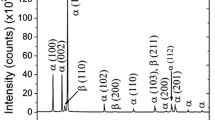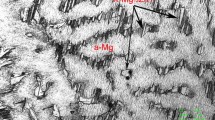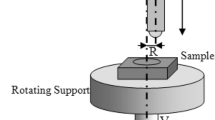Abstract
Wear properties of the nonhydrogenated, hydrogenated 0.5 wt%, and dehydrogenated Ti6Al4V alloys were studied through dry sliding wear tests using an M-200 type pin-on-disk wear testing machine in ambient air at room temperature to reveal the effects of hydrogen on wear properties of Ti6Al4V alloy. Morphology and chemical element of worn surface were investigated by means of scanning electron microscope (SEM) and energy dispersive spectroscopy (EDS). Results show that hydrogen decreases the wear resistance of Ti6Al4V alloy. Wear rate of the Ti6Al4V alloy increases after hydrogenation. Wear rate increases by 244.3 % when 0.5 wt% hydrogen is introduced into a Ti6Al4V alloy. Wear rate of the dehydrogenated Ti6Al4V alloy recovers. Wear mechanisms of the nonhydrogenated, hydrogenated, and dehydrogenated Ti6Al4V alloys are determined. The nonhydrogenated Ti6Al4V alloy is controlled by oxidative wear. The hydrogenated Ti6Al4V alloy is dominated by abrasive wear. Wear mechanism of the dehydrogenated Ti6Al4V alloys is a mixture of oxidative wear and abrasive wear.





Similar content being viewed by others
References
Chen Q, Zhao ZX, Shu DY, Zhao ZD. Microstructure and mechanical properties of AZ91D magnesium alloy prepared by compound extrusion. Mater Sci Eng A. 2011;528(10–11):3930.
Yang H, Fan XG, Sun ZC, Guo LG, Zhan M. Recent developments in plastic forming technology of titanium alloys. Sci China Technol Sci. 2011;54(2):490.
Chen Q, Zhao ZD, Zhao ZX, Hu CK, Shu DY. Microstructure development and thixoextrusion of magnesium alloy prepared by repetitive upsetting–extrusion. J Alloys Compd. 2011;509(26):7303.
Song HW, Zhang SH, Cheng M. Subtransus deformation mechanisms of TC11 titanium alloy with lamellar structure. Trans Nonferrous Met Soc China. 2010;20(11):2168.
Chen Q, Huang ZW, Zhao ZD, Hu CK. Thermal stabilities, elastic properties and electronic structures of B2-MgRE (RE = Sc, Y, La) by first-principles calculations. Comput Mater Sci. 2013;67:196.
Shi WY, Ma Y. Microstructure of ZM6 magnesium alloy with different Nd content. Rare Met. 2013;32(3):234.
Chen Q, Luo SJ, Zhao ZD. Microstructural evolution of previously deformed AZ91D magnesium alloy during partial remelting. J Alloys Compd. 2009;477(1–2):726.
Dimitriu S, Dobrescu M, Vasilescu M. Titanium and titanium-based alloys for aerospace. Met Int. 2009;14(7):14.
Liu R, Hui SX, Ye WJ, Li CL, Fu YY, Yu Y, Song XY. Dynamic stress–strain properties of Ti–Al–V titanium alloys with various element contents. Rare Met. 2013;32(6):555.
Rack HJ, Qazi JI. Titanium alloys for biomedical applications. Mater Sci Eng C. 2006;26(8):1269.
Fu MJ, Xu HY, Shao J, Han XQ. Superplastic deformation behavior of TA15 alloy sheet by superplastic tension. Chin J Rare Met. 2013;37(3):353.
Mello CB, Ueda M, Silva MM, Reuther H, Pichon L, Lepienski CM. Tribological effects of plasma immersion ion implantation heating treatments on Ti–6Al–4V alloy. Wear. 2009;267(5–8):867.
Wang YM, Jiang BL, Guo LX, Lei TQ. Tribological behavior of microarc oxidation coatings formed on titanium alloys against steel in dry and solid lubrication sliding. Appl Surf Sci. 2006;252(8):2989.
Masmoudi M, Assoul M, Wery M, Abdelhedi R, El Halouani F, Monteil G. Wear behaviour of nitric acid passivated cp Ti and Ti6Al4V. J Alloys Compd. 2009;478(1–2):726.
Molinari A, Straffelini G, Tesi B, Bacci T. Dry sliding wear mechanisms of the Ti6Al4V alloy. Wear. 1997;208(1–2):105.
Budinski KG. Tribological properties of titanium alloys. Wear. 1991;151(2):203.
Froes FH, Senkov ON, Qazi JO. Hydrogen as a temporary alloying element in titanium alloys: thermohydrogen processing. Int Mater Rev. 2004;49(3–4):227.
Yuan BG, Yu HP, Li CF, Sun DL. Effect of hydrogen on fracture behavior of Ti–6Al–4V alloy by in situ tensile test. Int J Hydrogen Energy. 2010;35(4):1829.
Senkov ON, Froes FH. Thermohydrogen processing of titanium alloys. Int J Hydrogen Energy. 1999;24(6):565.
Eliezer D, Eliaz N, Senkov ON, Froes FH. Positive effects of hydrogen in metals. Mater Sci Eng A. 2000;280(1):220.
Yuan BG, Li CF, Yu HP, Sun DL. Influence of hydrogen content on tensile and compressive properties of Ti–6Al–4V alloy at room temperature. Mater Sci Eng A. 2010;527(16–17):4185.
Zong YY, Liang YC, Yin ZW, Shan DB. Effects of hydrogen addition on the high temperature deformation behavior of TC21 titanium alloy. Int J Hydrogen Energy. 2012;37(18):13631.
Zhao JW, Ding H, Zhong YR, Lee CS. Effect of thermo hydrogen treatment on lattice defects and microstructure refinement of Ti6Al4V alloy. Int J Hydrogen Energy. 2010;35(12):6448.
Liang CP, Gong HR. Fundamental influence of hydrogen on various properties of alpha-titanium. Int J Hydrogen Energy. 2010;35(8):3812.
Ilyin AA, Skvortsova SV, Mamonov AM, Permyakova GV, Kurnikov DA. Effect of thermohydrogen treatment on the structure and properties of titanium alloy castings. Met Sci Heat Treat. 2002;44(5–6):185.
Bhosle V, Baburaj EG, Miranova M, Salama K. Dehydrogenation of TiH2. Mater Sci Eng A. 2003;356(1–2):190.
Li H, Hou HL, Sun ZG. Relationship between effect of hydrogen on physical and mechanical properties and its machinability for TC4 titanium alloy. Aeronaut Manuf Technol. 2008;20:80.
Acknowledgments
This study was financially supported by the National Natural Science Foundation of China (No. 51205102), and the China Postdoctoral Science Foundation (No. 2012M511401).
Author information
Authors and Affiliations
Corresponding author
Rights and permissions
About this article
Cite this article
Yuan, BG., Yu, HP., Li, CF. et al. Wear properties of nonhydrogenated, hydrogenated, and dehydrogenated Ti6Al4V alloy. Rare Met. 37, 574–578 (2018). https://doi.org/10.1007/s12598-014-0253-z
Received:
Revised:
Accepted:
Published:
Issue Date:
DOI: https://doi.org/10.1007/s12598-014-0253-z




